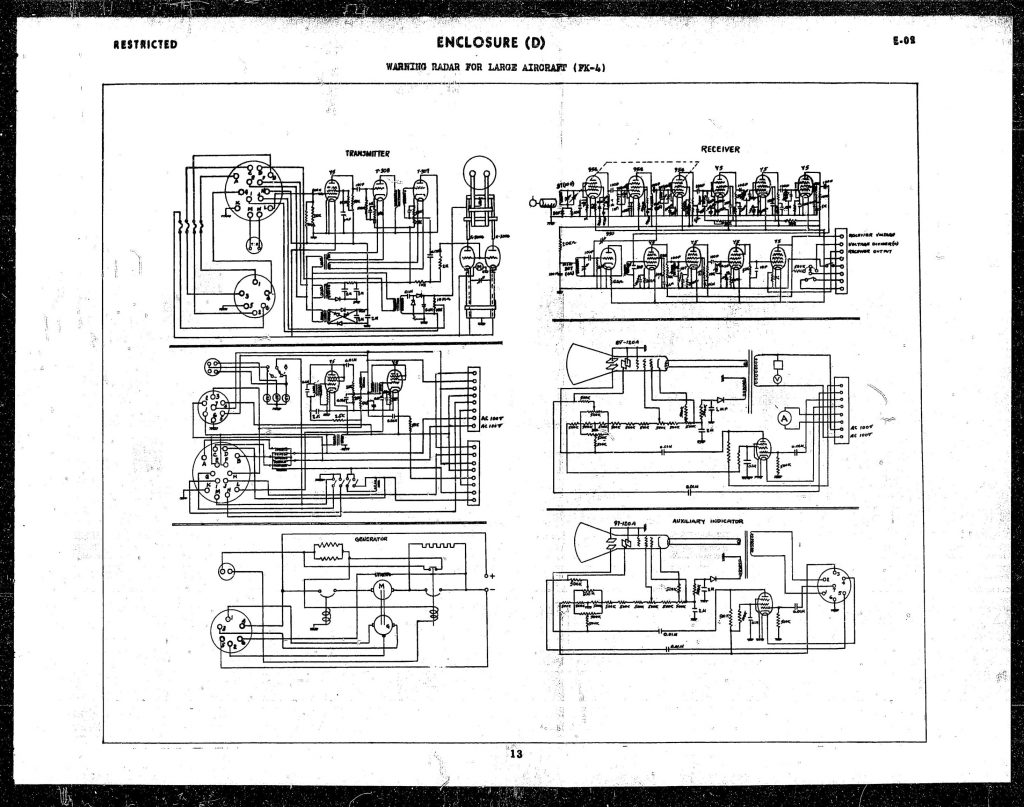十九試空一号電波探信儀十三型 (19-shi kū-1 Gō Denpa Tanshingi 10-gata ta, Protoype 19 Ku 1 Radio Probe Model 4 The FK-4, was to be a high power, large search radar to be mounted on large patrol planes. Like the FK-3, the FK-4 had two indicators, one for the pilot and one for the radar observer. The project started in June 1944, but was stopped in July 1945 before the first prototype could be completed after it was destroyed by air raids.
Reports of the U.S. Naval Technical Mission to Japan
Technical Specifications
| 十九試空一号電波探信儀十三型 / Protoype 19 Ku 1 Radio Probe Model 13 | ||||
|---|---|---|---|---|
| Designation | FK-4 | |||
| Object | Patrol and Search | |||
| Research | started | June 1944 | ||
| Finished | July 1945 | |||
| Operational status | Research stopped | |||
| Installation | Large aircraft | |||
| Frequency | 2 meter / 150 kHz | |||
| Power Output (Peak) | 20 kw | |||
| Pulse Length | 20 µs | |||
| Repetition Frequency | 83 c/s (500 c/s * 1/6) | |||
| Weight | unknown | |||
| Units build | 0 (prototype incomplete) | |||
| Transmitter | Oscillation Circuit | Modulated Oscillator | ||
| Oscillator Valve | K-3006 x2 | |||
| Receiver | Intermed. Freq. | 10 mc | ||
| Detector | 1st UN-954 | 2nd SORA | ||
| Local oscillator | UN-955 | |||
| Scope Representation |
Diameter | 120 mm | ||
| Scanning Axis | Linear | |||
| Scale | Mechanical | |||
| Antenna | Type | Head: Yagi | Sides: Folded Doublet | |
| Gain | 16db | 6.5db | ||
| Beam Angle | Horiz. | θƒ = 30° | θƒ = 28° | |
| Vertical | θƒ = 35° | θƒ = 30° | ||
| Max. Range (Max.Effective Scale) | 300 km theoretical 150 km against large ships |
|||
| Minimum Distance | 5 km at 1000 m | |||
| Accuracy of Range | ≃± 5% | |||
| Distance Discrimination | 5 km | |||
| Accuracy of Bearing | ± 3° | |||
| Angle Discrimination | ≃ 60° | |||
| No. Of Operators | Radar Technician | |||
Sources
- Defense Technical Information Center. (1945). A Short Survey of Japanese Radar. Volume 1.
- Defense Technical Information Center. (1945). A Short Survey of Japanese Radar. Volume 3.
- Mikesh, R. C. (2004). Japanese aircraft equipment: 1940-1945. Atglen: Schiffer Pub.
- Reports of the U.S. Naval Technical Mission to Japan, 1945-1946. (n.d.) (Vol. E-02 Japanese Airborne Radar).

